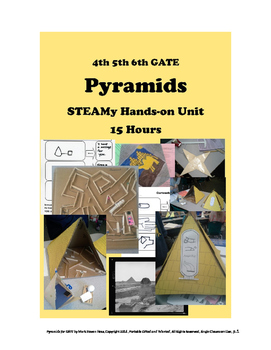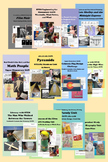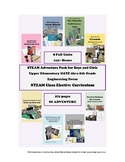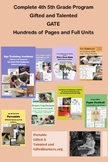STEAMy GATE 4th 5th 6th PYRAMIDS Unit
Portable Gifted and Talented
3.1k Followers
Grade Levels
4th - 7th
Resource Type
Standards
CCSS5.MD.A.1
CCSS7.G.B.6
CCSSRI.5.1
CCSSRI.5.2
CCSSRI.5.7
Formats Included
- Word Document File
Pages
44 pages
Portable Gifted and Talented
3.1k Followers
Also included in
- All of it fresh and new and tried and kid-tested during the past school year—you are ready to rock and roll for 2016-17!Here you have over 350 pages and 75 hours of material—all with best practices in gifted and talented education.One stop. Huge discount over individual purchases: you save 47%. SPrice $29.99Original Price $54.91Save $24.92
- 115+ hours of class time, 374 pages. This collection is big and includes big savings--42% off individual purchases of some. Pretty much everything in the Portable Gifted and Talented store is rated 4.0, but take a couple minutes to peruse the comments for these individual units. I think you’ll liPrice $34.99Original Price $51.42Save $16.43
- 5th grade Volume 1 is the top seller of all of the 200+ gifted and talented products in my store, but here's a secret . . . this may be even better! Yep . . . almost half off the individual prices.Full units including the most popular unit I have taught in 32 years -- Spy Training -- and PyramidPrice $24.99Original Price $45.93Save $20.94
Description
Very STEAMy with reading and writing, too! This unit is loaded with higher order thinking tasks, variety across the curriculum, creative responses, and hands-on learning through building and design. It’s the same sort of stuff you’re used to seeing here, and your kids will love it!
• Level—4th through 6th grade GATE
• Time—about 15 hours
• Materials—start saving cardboard!
Craft sticks and tape or low temp hot glue. Otherwise, common classroom materials.
You’ll get explanations, teacher notes, bunches of ready-to-print activity sheets, photos, sample answers, and everything you need to begin today! Oh, yes . . . and Common Core State Standards included.
Primary Source Photo Analysis: Introduce the unit with a photo from the United States Library of Congress. Can students build background and make inferences from the photo?
Short Research Project/Fortune Tellers: Students conduct a bit of research, write summaries, and complete an engineering task while making calculations to produce a creative fortune teller product. (I told you it was STEAMy with reading and writing . . .)
Marble Mazes: Students make marble maze puzzles to simulate pyramid passages. Fun, creative, and challenging . . . kids were skipping recess.
The Sphinx Riddle Challenge—Math Version: Math scaling/ratios with a primary source photo.
Pyramidion Design Challenge: a 3D blueprint and STEM challenge with geometry as the main focus.
The Afterlife: Crafting, social-emotional education, metaphor creation, and a strong public speaking activity all rolled together. The public speaking activity includes an organizational template, tips and tricks, and an evaluation rubric.
Hieroglyphics: We can’t leave out hieroglyphics! Students learn about hieroglyphics in a non-fiction reading and writing task requiring inferences and close reading about the Rosetta Stone. Students then play Egyptian scholars as they create translations for a hieroglyphic panel.
Pyramid Carry-Case and Cartouches: We start to wrap up our unit by creating cartouches (with more higher order thinking skills involved) which we place into our pyramid carrying cases.
• Level—4th through 6th grade GATE
• Time—about 15 hours
• Materials—start saving cardboard!
Craft sticks and tape or low temp hot glue. Otherwise, common classroom materials.
You’ll get explanations, teacher notes, bunches of ready-to-print activity sheets, photos, sample answers, and everything you need to begin today! Oh, yes . . . and Common Core State Standards included.
Primary Source Photo Analysis: Introduce the unit with a photo from the United States Library of Congress. Can students build background and make inferences from the photo?
Short Research Project/Fortune Tellers: Students conduct a bit of research, write summaries, and complete an engineering task while making calculations to produce a creative fortune teller product. (I told you it was STEAMy with reading and writing . . .)
Marble Mazes: Students make marble maze puzzles to simulate pyramid passages. Fun, creative, and challenging . . . kids were skipping recess.
The Sphinx Riddle Challenge—Math Version: Math scaling/ratios with a primary source photo.
Pyramidion Design Challenge: a 3D blueprint and STEM challenge with geometry as the main focus.
The Afterlife: Crafting, social-emotional education, metaphor creation, and a strong public speaking activity all rolled together. The public speaking activity includes an organizational template, tips and tricks, and an evaluation rubric.
Hieroglyphics: We can’t leave out hieroglyphics! Students learn about hieroglyphics in a non-fiction reading and writing task requiring inferences and close reading about the Rosetta Stone. Students then play Egyptian scholars as they create translations for a hieroglyphic panel.
Pyramid Carry-Case and Cartouches: We start to wrap up our unit by creating cartouches (with more higher order thinking skills involved) which we place into our pyramid carrying cases.
Total Pages
44 pages
Answer Key
Included with rubric
Teaching Duration
Other
Report this resource to TPT
Reported resources will be reviewed by our team. Report this resource to let us know if this resource violates TPT’s content guidelines.
Standards
to see state-specific standards (only available in the US).
CCSS5.MD.A.1
Convert among different-sized standard measurement units within a given measurement system (e.g., convert 5 cm to 0.05 m), and use these conversions in solving multi-step, real world problems.
CCSS7.G.B.6
Solve real-world and mathematical problems involving area, volume and surface area of two- and three-dimensional objects composed of triangles, quadrilaterals, polygons, cubes, and right prisms.
CCSSRI.5.1
Quote accurately from a text when explaining what the text says explicitly and when drawing inferences from the text.
CCSSRI.5.2
Determine two or more main ideas of a text and explain how they are supported by key details; summarize the text.
CCSSRI.5.7
Draw on information from multiple print or digital sources, demonstrating the ability to locate an answer to a question quickly or to solve a problem efficiently.





